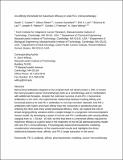An affinity threshold for maximum efficacy in anti-PD-1 immunotherapy
Author(s)
Cowles, Sarah C.; Sheen, Allison; Santollani, Luciano; Lutz, Emi A.; Lax, Brianna M.; Palmeri, Joseph R.; Freeman, Gordon J.; Wittrup, K. Dane; ... Show more Show less
DownloadKMAB-2022-0057R1_Wittrup_edited (1).pdf (3.347Mb)
Open Access Policy
Open Access Policy
Creative Commons Attribution-Noncommercial-Share Alike
Additional downloads
Open Access Policy
Open Access Policy
Creative Commons Attribution-Noncommercial-Share Alike
Terms of use
Metadata
Show full item recordAbstract
Monoclonal antibodies targeted to the programmed cell death protein 1 (PD-1) remain the most prevalent cancer immunotherapy both as a monotherapy and in combination with additional therapies. Despite the extensive success of anti-PD-1 monoclonal antibodies in the clinic, the experimental relationship between binding affinity and functional potency for anti-PD-1 antibodies in vivo has not been reported. Anti-PD-1 antibodies with higher and lower affinity than the nivolumab or pembrolizumab are entering the clinic and show varied preclinical efficacy. Here, we explore the role of broad-ranging affinity variation within a single lineage in a syngeneic immunocompetent mouse model. By developing a panel of murine anti-PD-1 antibodies with varying affinity (ranging from KD = 20 pM - 15 nM), we find that there is a threshold affinity required for maximum efficacy at a given dose in the treatment of the MC38 adenocarcinoma model with anti-PD-1 immunotherapy. Physiologically based pharmacokinetic modeling complements interpretation of the experimental results and highlights the direct relationship between dose, affinity, and PD-1 target saturation in the tumor.
Date issued
2022-08-04Department
Koch Institute for Integrative Cancer Research at MIT; Massachusetts Institute of Technology. Department of Chemical Engineering; Massachusetts Institute of Technology. Department of Biological EngineeringJournal
mAbs
Publisher
Taylor & Francis
Citation
Cowles, Sarah C., Sheen, Allison, Santollani, Luciano, Lutz, Emi A., Lax, Brianna M. et al. 2022. "An affinity threshold for maximum efficacy in anti-PD-1 immunotherapy." mAbs, 14 (1).
Version: Author's final manuscript
ISSN
1942-0862
1942-0870